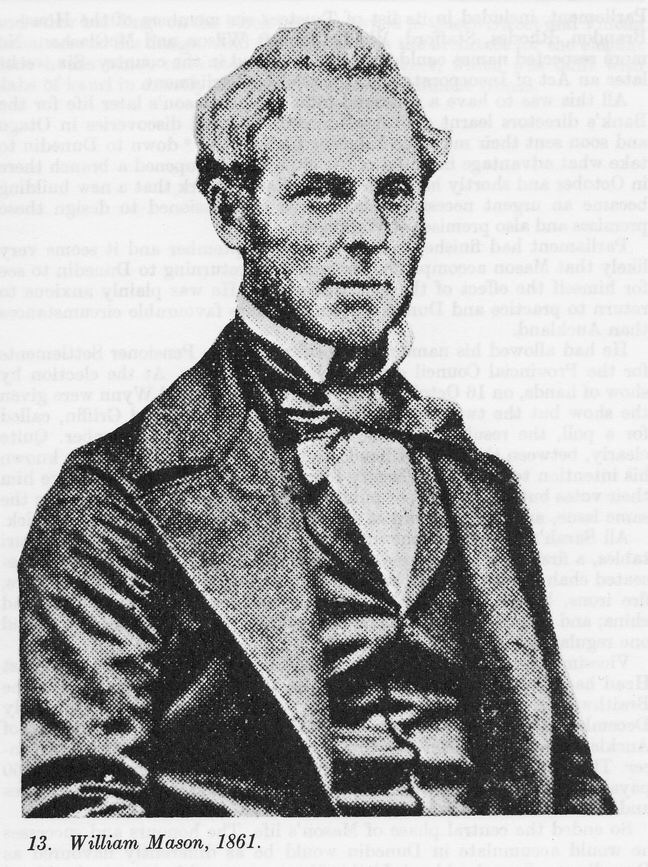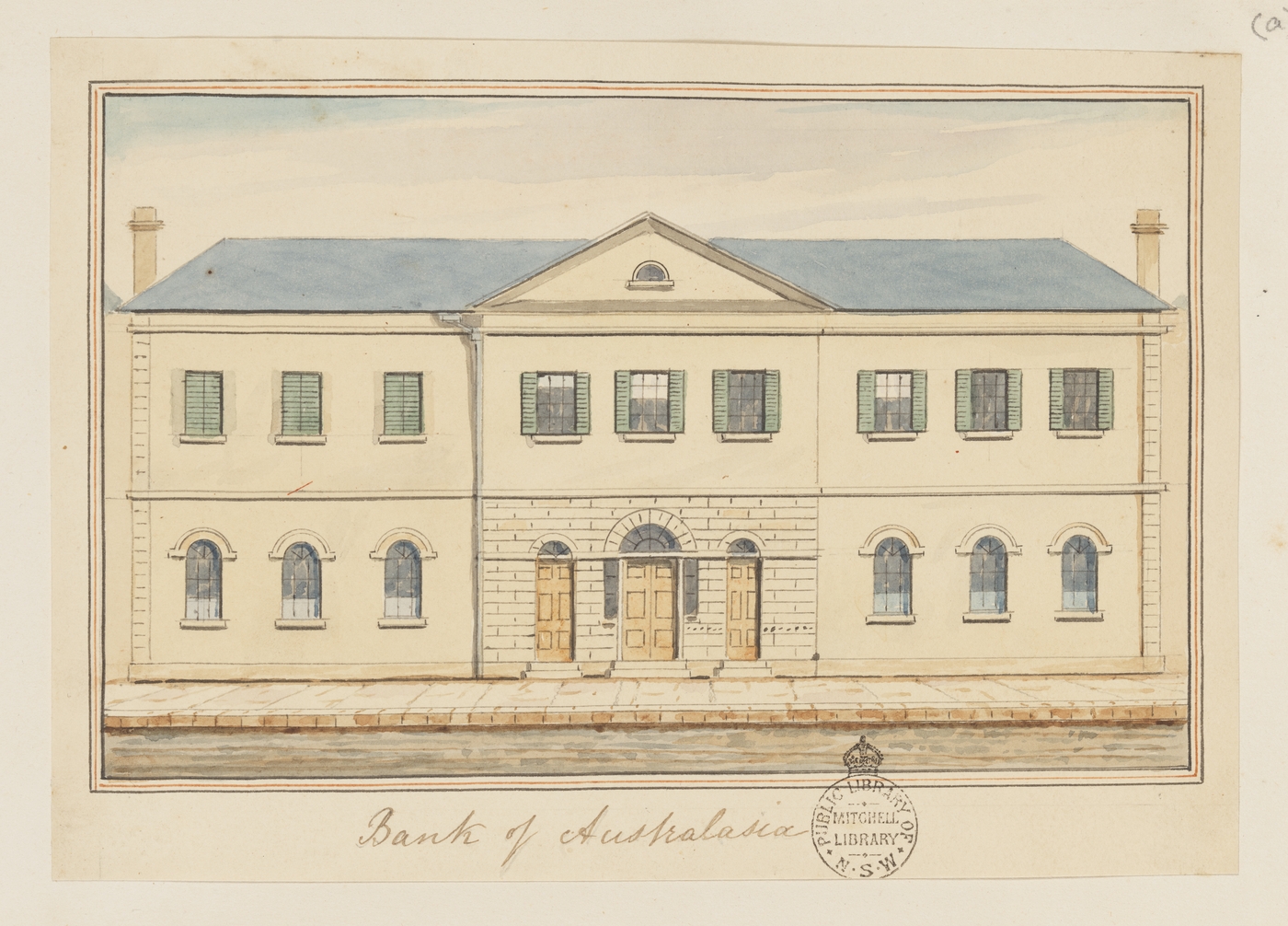|
William Mason (architect)
William Mason (24 February 1810 – 22 June 1897) was a New Zealand architect born in Ipswich, England, the son of an architect/builder George Mason and Susan, née Forty. Trained by his father he went to London where he seems to have worked for Thomas Telford (1757–1834). He studied under Peter Nicholson (architect), Peter Nicholson (1765–1844) before eventually working for Edward Blore (1787–1879). In 1831 he married Sarah Nichols, a Berkshire woman apparently fifteen years older than he was. A son was born in the first year of their marriage. In 1836 he returned to Ipswich to practise. Having worked at Lambeth Palace he had attracted the interest of the bishop of London, who now employed him independently designing churches and parsonages. These included three commissions for churches in Essex: St Lawrence, East Donyland; St Botolph, Colchester; and St James, Brightlingsea. The most remarkable of these is St Botolph's (1838) in white brick and Norman style. Apparently Geo ... [...More Info...] [...Related Items...] OR: [Wikipedia] [Google] [Baidu] |
William Mason Architect
William is a male given name of Germanic languages, Germanic origin.Hanks, Hardcastle and Hodges, ''Oxford Dictionary of First Names'', Oxford University Press, 2nd edition, , p. 276. It became very popular in the English language after the Norman conquest of England in 1066,All Things William"Meaning & Origin of the Name"/ref> and remained so throughout the Middle Ages and into the modern era. It is sometimes abbreviated "Wm." Shortened familiar versions in English include Will (given name), Will, Wills (given name), Wills, Willy, Willie, Bill (given name), Bill, and Billy (name), Billy. A common Irish people, Irish form is Liam. Scottish people, Scottish diminutives include Wull, Willie or Wullie (as in Oor Wullie or the play Douglas (play)#Theme and response, ''Douglas''). Female forms are Willa, Willemina, Wilma (given name), Wilma and Wilhelmina (given name), Wilhelmina. Etymology William is related to the given name ''Wilhelm'' (cf. Proto-Germanic ᚹᛁᛚᛃᚨᚺᛖᛚ� ... [...More Info...] [...Related Items...] OR: [Wikipedia] [Google] [Baidu] |
Wellington
Wellington ( mi, Te Whanganui-a-Tara or ) is the capital city of New Zealand. It is located at the south-western tip of the North Island, between Cook Strait and the Remutaka Range. Wellington is the second-largest city in New Zealand by metro area, and is the administrative centre of the Wellington Region. It is the world's southernmost capital of a sovereign state. Wellington features a temperate maritime climate, and is the world's windiest city by average wind speed. Legends recount that Kupe discovered and explored the region in about the 10th century, with initial settlement by Māori iwi such as Rangitāne and Muaūpoko. The disruptions of the Musket Wars led to them being overwhelmed by northern iwi such as Te Āti Awa by the early 19th century. Wellington's current form was originally designed by Captain William Mein Smith, the first Surveyor General for Edward Wakefield's New Zealand Company, in 1840. The Wellington urban area, which only includes urbanised ar ... [...More Info...] [...Related Items...] OR: [Wikipedia] [Google] [Baidu] |
Exchange Building, Dunedin
Princes Street (often misspelt as "Princess Street") is a major street in Dunedin, the second largest city in the South Island of New Zealand. It runs south-southwest for two kilometres from The Octagon in the city centre to the Oval sports ground, close to the city's Southern Cemetery. North of The Octagon, George Street continues the line of Princes Street north-northeast for two and a half kilometres. Princes Street is straight and undulates as it skirts the edge of the City Rise to its northwest. The part of the street immediately below The Octagon is the steepest section, as the road traverses an old cutting through Bell Hill. Princes Street was developed during Dunedin's 1860s boom from the Central Otago gold rush, and consequently is one of New Zealand's most historic streets, with about 70 buildings in close proximity listed on the New Zealand Historic Places Trust Register. Originally the site of the city's wharf, a substantial area of land to the east of the street ... [...More Info...] [...Related Items...] OR: [Wikipedia] [Google] [Baidu] |
Covent Garden
Covent Garden is a district in London, on the eastern fringes of the West End, between St Martin's Lane and Drury Lane. It is associated with the former fruit-and-vegetable market in the central square, now a popular shopping and tourist site, and with the Royal Opera House, itself known as "Covent Garden". The district is divided by the main thoroughfare of Long Acre, north of which is given over to independent shops centred on Neal's Yard and Seven Dials, while the south contains the central square with its street performers and most of the historical buildings, theatres and entertainment facilities, including the London Transport Museum and the Theatre Royal, Drury Lane. The area was fields until briefly settled in the 7th century when it became the heart of the Anglo-Saxon trading town of Lundenwic, then abandoned at the end of the 9th century after which it returned to fields. By 1200 part of it had been walled off by the Abbot of Westminster Abbey for use as arable l ... [...More Info...] [...Related Items...] OR: [Wikipedia] [Google] [Baidu] |
Charles Fowler
Charles Fowler (17 May 1792 – 26 September 1867) was an English architect, born and baptised at Cullompton, Cullompton, Devon. He is especially noted for his design of market buildings, including Covent Garden Market in London. Life Education and early work Fowler was born at Cullompton, Devon on 17 May 1792, and baptised on 26 December 1800, also at Cullompton. He was educated at Taunton Grammar School After serving an apprenticeship of seven years with John Powning of Exeter, he moved to London in 1814, and entered the office of David Laing (architect), David Laing, where he assisted him on the designs for the Custom House, City of London, Custom House. He then set up his own practice, working from an address in Great Ormond Street, and later, from 1830, at 1, Gordon Square. Fowler generally worked in a classical style, often freely interpreted. Thomas Leverton Donaldson described him as "gifted with a practical rather than an imaginative turn of mind.". An important ear ... [...More Info...] [...Related Items...] OR: [Wikipedia] [Google] [Baidu] |
George O'Brien (painter)
George O'Brien (1821–1888) was an engineer of aristocratic background who turned to art in 19th century Australasia, dying in poverty but leaving a body of remarkable work. Biography George O'Brien was born at Dromoland Castle County Clare, Ireland in 1821 he was the fifth son of Admiral Robert O'Brien, a younger son of Sir Lucius O'Brien, 3rd Baronet. George O'Brien was a first cousin of William Smith O'Brien (1803–1864) deported to Tasmania for his part in the 1848 'Young Ireland' uprising, and a cousin too of James FitzGerald, at one time Superintendent of the Canterbury Province in New Zealand. Despite these distinguished connections the family was not well-heeled. Young George O'Brien may have been trained by a brother as a civil engineer. His parents died when he was young and it seems that by a very early age he was in Melbourne, Australia. Views of the town dated 1839 and 1840 survive in the collection of the state library. It seems he left soon afterwards but was b ... [...More Info...] [...Related Items...] OR: [Wikipedia] [Google] [Baidu] |
New Zealand Exhibition
The New Zealand Exhibition held in Dunedin, New Zealand, in 1865 was a world's fair visited by 31250 people. It was the first world's fair held in New Zealand. It opened on 12 January and ran until 6 May 1865. Organisation Following the Bazaar and Industrial Exhibition of 1862, held in Dunedin, a group of gentlemen formed a committee for the promotion of a similar exhibition to be held on a larger scale in Dunedin in 1865. An application was made in February 1863 to the Governor requesting the formation of a Royal Commission, which was granted in May. The Provincial Government provided the sum of £4,000 for the aid of general purposes and another £4,000 to build a suitable building. John Hyde Harris was president of the executive, James Hector was commissioner and juror, Alfred Eccles the secretary and Thomas Forrester building superintendent. Architecture A low-level site on King Street was secured and a contract was let to Messrs. George Cornwell and Edward Horsman on No ... [...More Info...] [...Related Items...] OR: [Wikipedia] [Google] [Baidu] |
William Clayton (architect)
William Henry Clayton (17 November 1823 – 23 August 1877) was a Tasmanian-born colonial architect who practised initially in Tasmania and then in New Zealand. He was New Zealand's first (and only) Colonial Architect, serving in the position from 1869 up until his death. In this role, he and his office were responsible for the design of numerous government buildings. Early life and education William was born on 17 November 1823, at Norfolk Plains, Australia. William's grandfather (who bore the same name) had been sentenced in 1802 to transportation for seven years to Australia for the possession of a purportedly stolen sheepskin. His wife Sarah and three-year-old Henry accompanied him on the convict ship ''Glatton'' which reached New South Wales in 1803. At the age of 16 Henry received a land grant in Tasmania, which enabled him to become a prosperous businessman by the time his son William was born. As well as land holdings, by the 1840s Henry also owned several flour mills ... [...More Info...] [...Related Items...] OR: [Wikipedia] [Google] [Baidu] |
Globe Theatre, Dunedin
Globe Theatre is a theatre located in Dunedin, New Zealand, and the amateur theatre company that runs it. The theatre was built in 1961 by Patric and Rosalie Carey as an extension of their house. The building to which it is attached, at 104 London Street, was designed by architect William Mason as his own house and built in 1864. Ralph Hotere designed both sets and costumes for the theatre productions. The foyer area was also used for exhibitions, notably the Waterfall paintings of Colin McCahon, paintings by Michael Smither, and pots by Barry Brickell, Len Castle, and Doreen Blumhardt. 104 London Street as residence The large family house at 104 London Street was designed by architect William Mason as his own house and built in 1864. Mason built his residence at 104 London Street in 1864. When he retired to Glenorchy, he sold the house to Robert Blackadder, a Dunedin merchant, who occupied it from 1879 to 1901, and then sold it to Dunedin draper Herbert Haynes, who resided ... [...More Info...] [...Related Items...] OR: [Wikipedia] [Google] [Baidu] |
Nathaniel Wales (architect)
Nathaniel Young Armstrong Wales (1832 – 3 November 1903) was a 19th-century architect, Member of Parliament, and Mayor in Dunedin, Otago, New Zealand. Biography Wales was born in Northumberland, England. He trained as an architect in Jedburgh, Scotland. He joined the Victorian gold rush in its early days and then migrated to Dunedin in 1861. He was employed by the architect William Mason and in 1871 joined him as a partner in the firm. He represented the City of Dunedin electorate from to 1875, when he retired. He was later Mayor of Dunedin from 1895 to 1896. Coincidentally, Wales' partner Mason had held the same position during the 1860s. Notable designs One of his notable designs is his own house at 38 Belgrave Crescent, which was built from stones quarried on the site. He designed the New Zealand Insurance Company Building, which is located on the corner of Queens Gardens and Crawford Street, and which is registered as a Category I heritage by Heritage New Zealan ... [...More Info...] [...Related Items...] OR: [Wikipedia] [Google] [Baidu] |
Bank Of Australasia
The Bank of Australasia was an Australian bank in operation from 1835 to 1951. Headquartered in London, the bank was incorporated by Royal Charter in March 1834. It had initially been planned to additionally include first South Africa and then Ceylon in the bank's operations; however, both these moves were blocked by the Lords of the Treasury. Its first branch opened in Sydney on 14 December 1835, followed by branches in Hobart and Launceston on 1 January 1836, in the latter city by taking over the former Cornwall Bank. A Melbourne branch opened on 28 August 1838 and an Adelaide branch on 14 January 1839. It opened a Perth branch in May 1841 when it absorbed the original Bank of Western Australia; however, the branch was closed in 1844 and the bank would not reopen in that city until 1894. It suffered financial difficulties during the 1840s depression, in part because of a controversial loan to the failing Bank of Australia which resulted in significant litigation. Having op ... [...More Info...] [...Related Items...] OR: [Wikipedia] [Google] [Baidu] |
Thomas Gillies
Thomas Bannatyne Gillies (17 January 1828 – 26 July 1889) was a 19th-century New Zealand lawyer, judge and politician. Early life He was born at Rothesay on the Isle of Bute, Scotland, on 17 January 1828. He was the eldest of nine children of John Gillies, local lawyer and town clerk, and his wife, Isabella Lillie, daughter of a Glasgow businessman and granddaughter of a Huguenot refugee. Determined to train as a mechanical engineer, he was forced by his father to study law and trained in his father's practice for four years. He then went to Manchester, where he worked for Robert Barbour and Sons, with his next brother John taking his place in his father's firm. The two brothers intended to join the California Gold Rush but their father did not allow them to do so, and John emigrated to Australia instead in about 1850. John Gillies senior was so committed with various duties that his health suffered and after long discussions, it was agreed to emigrate to Otago, New Zealand. O ... [...More Info...] [...Related Items...] OR: [Wikipedia] [Google] [Baidu] |








